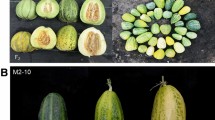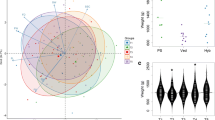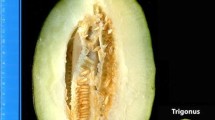Abstract
Background
Fruit morphology traits are important commercial traits that directly affect the market value. However, studying the genetic basis of these traits in un-explored botanical groups is a fundamental objective for crop genetic improvement through marker-assisted breeding.
Methods and results
In this study, a quantitative trait loci (QTLs) mapping strategy was used for dissecting the genomic regions of fruit linked morphological traits by single nucleotide polymorphism (SNP) based cleaved amplified polymorphism sequence (CAPS) molecular markers. Next-generation sequencing was done for the genomic sequencing of two contrasted melon lines (climacteric and non-climacteric), which revealed 97% and 96% of average coverage over the reference melon genome database, respectively. A total of 57.51% non-synonymous SNPs and 42.49% synonymous SNPs were found, which produced 149 sets of codominant markers with a 24% polymorphism rate. Total 138-F2 derived plant populations were genotyped for linkage mapping and composite interval mapping based QTL mapping exposed 6 genetic loci, positioned over distinct chromosomes (02, 04, 08, 09, and 12) between the flanking intervals of CAPS markers, which explained an unlinked polygenic architecture in genome. Three minor QTLs of fruit weight (FWt2.1, FWt4.1, FWt9.1), one major QTL of fruit firmness (FrFir8.1), one major QTL of fruit length (FL12.1), and one major QTL of fruit shape (FS12.1) were determined and collectively explained the phenotypic variance from 5.64 to 15.64%. Fruit phenotypic correlation exhibited the significant relationship and principal component analysis also identified the potential variability. Multiple sequence alignments also indicated the significant base-mutations in the detected genetic loci, respectively.
Conclusion
In short, our illustrated genetic loci are expected to provide the reference insights for fine QTL mapping and candidate gene(s) mining through molecular genetic breeding approaches aimed at developing the new varieties.






Similar content being viewed by others
Data availability
The possible datasets generated for this study can be found in the manuscript and attached supplementary material.
References
Perin C, Hagen LS, De Conto V, Katzir N, Danin-Poleg Y, Portnoy V, Baudracco-Arnas S, Chadoeuf J, Dogimont C, Pitrat M (2002) A reference map of Cucumis melo based on two recombinant inbred line populations. Theor Appl Genet 104:1017–1034
Moreno E, Obando JM, Dos-Santos N, Fernández-Trujillo JP, Monforte AJ, Garcia-Mas J (2008) Candidate genes and QTLs for fruit ripening and softening in melon. Theor Appl Genet 116(4):589–602
Ramamurthy KR, Waters BM (2015) Identification of fruit quality and morphology QTLs in melon (Cucumis melo) using a population derived from flexuosus and cantalupensis botanical groups. Euphytica 204(1):163–177
Diaz A, Fergany M, Formisano G, Ziarsolo P, Blanca J, Fei Z, Staub JE, Zalapa JE, Cuevas HE, Dace G, Oliver M, Boissot N, Dogimont C, Pitrat M, Hofstede R, Koert PV, Harel-Beja R, Tzuri G, Portnoy V, Cohen S, Schaffer A, Katzir N, Xu Y, Zhang H, Fukino N, Matsumoto S, Gracia-Mas J, Monforte AJ (2011) A consensus linkage map for molecular markers and quantitative trait loci associated with economically important traits in melon (Cucumis melo L.). BMC Plant Biol 11:111
Saladié M, Cañizares J, Phillips MA, Rodriguez-Concepcion M, Larrigaudière C, Gibon Y, Stitt M, Lunn JE, Gracia-Mas J (2015) Comparative transcriptional profiling analysis of developing melon (Cucumis melo L.) fruit from climacteric and non-climactericvarieties. BMC Genomics 16:44
Pereira L, Snat Domingo M, Ruggieri V, Argyris J, Philips MA, Zhao G, Lian Q, Xu Y, He Y, Huang S, Pujol M, Gracia-Mas J (2020) Genetic dissection of climacteric fruit ripening in a melon population segregating for ripening behavior. Hort Res 7:187
Zarid M, García-Carpintero V, Esteras C (2020) Transcriptomic analysis of a near-isogenic line of melon with high fruit flesh firmness during ripening. J Sci Food Agric 101(2):754–777
Sun L, Zhang Y, Cui H, Zhang L, Sha T, Wang C, Fan C, Luan F, Wang X (2020) Linkage mapping and comparative transcriptome analysis of firmness in watermelon (Citrullus lanatus). Front Plant Sci 11:831
Zhang T, Ding Z, Liu J, Qiu B, Gao P (2020) QTL mapping of pericarp and fruit-related traits in melon (Cucumis melo L.) using SNP-derived CAPS markers. Sci Hortic 265:109243
Amanullah S, Liu S, Gao P, Zhu Z, Zhu Q, Fan C, Luan F (2018) QTL mapping for melon (Cucumis melo L.) fruit traits by assembling and utilization of novel SNPs based CAPS markers. Sci Hortic 236(29):18–29
Pitrat M (2013) Phenotypic diversity in wild and cultivated melons (Cucumis melo). Plant Biotechnol 30(3):273–278
Monforte AJ, Diaz A, Cano-Delgado A, Vander Knaap E (2014) The genetic basis of fruit morphology in horticultural crops: lessons from tomato and melon. J Exp Bot 65(16):4625–4637
Diaz A, Zarouri B, Fergany M, Eduardo I, Alvarez JM, Pico B, Monforte JM (2014) Mapping and introgression of QTL involved in fruit shape transgressive segregation into ‘Piel de Sapo’ melon (Cucumis melo L.). PLoS ONE 9(8):e104188
Diaz A, Martín-Hernández AM, Dolcet-Sanjuan R, Graces-Claver A, Alvarez JM, Gracias-Mas J, Pico B, Monforte AJ (2017) Quantitative trait loci analysis of melon (Cucumis melo L.) domestication-related traits. Theor Appl Genet 130(9):1837–1856
Oren E, Tzuri G, Dafna A, Meir A, Kumar R, Katzir N, Elknd Y, Feriliich S, Schaffer AA, Tadmor Y, Burger J, Gur A (2020) High-density NGS-based map construction and genetic dissection of fruit shape and rind netting in Cucumis melo. Theor Appl Genet 133:1927–1945
Nimmakayala P, Tomason YR, Abburi VL, Alvarado A, Saminathan T, Vajja VG, Salazar G, Panicker GK, Levi A, Wechter WP, McCreight JD, Korol AB, Ronin Y, Garcia-Mas J, Reddy UK (2016) Genome-wide differentiation of various melon horticultural groups for use in GWAS for fruit firmness and construction of a high resolution genetic map. Front Plant Sci 7:1437
Vegas J, Garcia-Mas J, Monforte AJ (2013) Interaction between QTLs induces an advance in ethylene biosynthesis during melon fruit ripening. Theor Appl Genet 126(6):1531–1544
Natarajan S, Kim HT, Thamilarasan SK, Veerappan K, Park JI, Nou IS (2016) Whole genome re-sequencing and characterization of powdery mildew disease-associated allelic variation in melon. PLoS ONE 11(6):e0157524
Garcia-Masa J, Benjaka A, Sanseverinoa W, Bourgeoisa M, Mira G, Gonzálezb VM, Hénaffb E, Câmarac F, Cozzutoc L, Lowyc E, Aliotod T, Capella-Gutiérrezc S, Blancae J, Cañizarese J, Ziarsoloe P, Gonzalez-Ibeasf D, Rodríguez-Morenof L, Droegeg M, Duh L, Alvarez-Tejadoi M, Lorente-Galdosj B, Melé M, Yangk L, Weng Y, Navarro A, Marques-Bonet T, Aranda MA, Nueze F, Pico B, Gabaldónc T, Roma G, Guigó R, Casacubertab JM, Arús P, Puigdomènech P (2012) The genome of melon (Cucumis melo L.). PNAS 109:11872–11877
Liu S, Gao P, Zhu Q, Luan F, Davis AR, Wang X (2016) Development of cleaved amplified polymorphic sequence markers and a CAPS based genetic linkage map in watermelon (Citrullus lanatus [Thunb.] Matsum. and Nakai) constructed using whole-genome re-sequencing data. Breed Sci 66:244–259
Leida C, Moser C, Esteras C, Sulpice R, Lunn JE, De Langen F, Monforte AJ, Pico B (2015) Variability of candidate genes, genetic structure and association with sugar accumulation and climacteric behavior in a broad germplasm collection of melon (Cucumis melo L.). BMC Genet 16:28
Wang YH, Wu DH, Hang JH, Tsao SJ, Hwu KK, Lo HF (2016) Mapping quantitative trait loci for fruit traits and powdery mildew resistance in melon (Cucumis melo). Bot Stud 57:19
Pereira L, Ruggieri V, Pérez S, Alexiou KG, Fernández M, Jahrmann M, pujol M, Gracia-Mas M, (2018) QTL mapping of melon fruit quality traits using a high-density GBS-based genetic map. BMC Plant Biol 18:324
Zhang T, Liu J, Liu S, Ding Z, Luan F, Gao P (2019) Bulked-segregant analysis identified a putative region related to short internode length in melon. Hortic Sci 54(8):1293–1298
Liu L, Sun T, Liu X, Guo Y, Huang X, Gao P, Wang X (2019) Genetic analysis and mapping of a striped rind gene (st3) in melon (Cucumis melo L.). Euphytica 215:20
Li B, Zhao Y, Zhu Q, Zhang Z, Fan C, Amanullah S, Gao P, Luan F (2017) Mapping of powdery mildew resistance genes in melon (Cucumis melo L.) by bulked segregant analysis. Sci Hortic 220:160–167
Amanullah S, Gao P, Osae BA, Saroj A, Yang T, Lis S, Weng Y, Luan F (2021) Genetic linkage mapping and QTLs identification for morphology and fruit quality related traits of melon by SNP based CAPS markers. Sci Hortic 278:109849
Amanullah S, Saroj A, Osae BA, Liu S, Liu H, Gao P, Luan FS (2020) Detection of putative QTL regions associated with ovary traits in melon using SNP-CAPS markers. Sci Hortic 270:109445
Doyle JJ, Doyle JL (1987) A rapid DNA isolation procedure for small quantities of fresh leaf tissue. Phytochem Bull 19:11–15
Thiel T, Kota R, Grosse I, Stein N, Graner A (2004) SNP2CAPS: a SNP and INDEL analysis tool for CAPS marker development. Nucleic Acids Res 32(1):e5
Meng L, Li H, Zhang L, Wang J (2015) QTL Ici mapping: integrated software for genetic linkage map construction and quantitative trait locus mapping in biparental populations. Crop J 3:269–283
Wickham H (2009) ggplot2: elegant graphics for data analysis. Springer, New York
Luan F, Fan C, Sun L, Cui H, Amanullah S, Tang L, Gao P (2019) Genetic mapping reveals a candidate gene for egusi seed in watermelon. Euphytica 215:182
Harel-Beja R, Tzuri G, Portnoy V, Lotan-Pompan M, Lev S, Cohen S, Dai N, Yeselson L, Meir A, Libhaber SE, Avisa E, Melame T, van Koert P, Verbakel H, Hofstede R, Volpin H, Oliver M, Fougedoire A, Stalh C, Fauve J, Copes B, Fei Z, Giovannoni J, Ori N, Lewinsohn E, Sherman A, Burger J, Tamdor Y, Schaffer AA, Katzir N (2010) A genetic map of melon highly enriched with fruit quality QTLs and EST markers, including sugar and carotenoid metabolism genes. Theor Appl Genet 121:511–533
Wu S, Zhang B, Keyhaninejad N, Rodriguez GR, Kim HJ, Chakrabarti M, Illa-Berenguer E, Taitano NK, Gonzalo MJ, Diaz A, Pan Y, Leisner CP, Halterman D, Buell CR, Weng Y, Jansky SH, van Eck H, Willemsen J, Monforte AJ, Meulia T, van der Knaap E (2018) A common genetic mechanism underlies morphological diversity in fruits and other plant organs. Nat Commun 9:4734
Huang Z, Van Houten J, Gonzalez G, Xiao H, Van Der Knaap E (2013) Genome-wide identification, phylogeny and expression analysis of SUN, OFP and YABBY gene family in tomato. Mol Genet Genom 288:111–129
Chu YH, Jang JC, Huang Z, van der Knaap E (2019) Tomato locule number and fruit size controlled by natural alleles of lc and fas. Plant Direct 3:e00142
Grewal TS, Rossnagel BG, Scoles GJ (2010) Validation of molecular markers associated with net blotch resistance and their utilization in barley breeding. Crop Sci 50:177–184
Yang T, Zhang P, Pan J, Amanullah S, Luan F, Han W, Liu H, Wang X (2022) Genome-wide analysis of the Peroxidase gene family and verification of lignin synthesis-related genes in watermelon. Int Mol J Sci 23(2):642
Dos-santos N, Jimenez-Araujo A, Rodriguez-Arcos R, Fernanndez-trujillo JP (2011) Cell wall polysacharides of near-isogenic lines of melon (Cucumis melo L.) and their inbred parentals which show differential flesh firmness or physiological behavior. J Agric Food Chem 59(14):7773–7784
Peter MA, David T, Brummell A (2007) Biochemical bases of appearance and texture changes in fresh-cut fruit and vegetables. Postharvest Biol Technol 48:1–14
Goulao LF, Cosgrove DJ, Oliveira CM (2007) Cloning, characterization and expression analyses of cDNA clones encoding cell wall-modifying enzymes isolated from ripe apples. Postharvest Biol Technol 48:37–51
Gao G, Duan XY, Jiang HC, Yang F, Qi HY (2021) CmMYB113 regulates ethylene-dependent sucrose accumulation in postharvest climacteric melon fruit. Postharvest Biol Technol 181:111682
Yoko S, Masaki F, Mamiko K, Toshitsugu N, Junji K, Nobutaka SNK, Junichi S, Toshihide N, Takafumi K, Yasuhiro I (2014) Tomato FRUITFULL homologs regulate fruit ripening via ethylene biosynthesis. Biosci Biotechnol Biochem 78:231–237
Brummell DA, Harpster MH, Dunsmuir P (1999) Differential expression of expansion gene family members during growth and ripening of tomato fruit. Plant Mol Biol 39(1):161–169
Cao Y, Tang X, Giovannoni J, Xiao F, Liu Y (2012) Functional characterization of a tomato COBRA-like gene functioning in fruit development and ripening. BMC Plant Biol 12(1):1–15
Girard AL, Mounet F, Lemaire-Chamley M, Gaillard C, Elmorjani K, Vivancos J, Runavot JL, Quemener B, Petot J, Germain V, Rothan C, Marion D, Bakan B (2012) Tomato GDSL1 is required for cutin deposition in the fruit cuticle. Plant Cell 24(7):3119–3134
Shi JX, Adato A, Alkan N, He Y, Lashbrooke J, Matas AJ, Meir S, Malitsky S, Isaacson T, Prusky D, Leshkowitz D, Schreiber L, Granell AR, Widemann E, Grausem B, Pinot F, Rose JKC, Rogachev I, Rothan C, Aharoni A (2013) The tomato S l SHINE 3 transcription factor regulates fruit cuticle formation and epidermal patterning. New Phytol 197(2):468–480
Arzani A, Ashraf M (2016) Smart engineering of genetic resources for enhanced salinity tolerance in crop plants. Crit Rev Plant Sci 35:146–189
van der Knaap E, Chakrabarti M, Chu YH, Clevenger JP, Illa-Berenguer E, Huang Z, Keyhaninejad N, Mu Q, Sun L, Wang Y, Wu S (2014) What lies beyond the eye: the molecular mechanisms regulating tomato fruit weight and shape. Front Plant Sci 5:1–13
van der Knaap E, Ostergaard L (2018) Shaping a fruit: Developmental pathways that impact growth patterns. Semin Cell Dev Biol 79:27–36
Weng Y, Colle M, Wang Y, Yang L, Rubinstein M, Sherman A, Ophir R, Grumet R (2015) QTL mapping in multiple populations and development stages reveals dynamic quantitative trait loci for fruit size in cucumbers of different market classes. Theor Appl Genet 128:1747–1763
Lazzaro MD, Wu S, Snoufer A, Wang Y, van der Knaap E (2018) Plant organ shapes are regulated by protein interactions and associations with microtubules. Front Plant Sci 9:1766
Wei Q, Fu WY, Wang YZ, Qin XD, Wang J, Li J, Lou QF, Chen JF (2016) Rapid identification of fruit length loci in cucumber (Cucumis sativus L.) using next-generation sequencing (NGS)-based QTL analysis. Sci Rep 6:27496
Wu Z, Sun S, Wang F, Guo D (2011) Establishment of regeneration and transformation system of Lycopresicon esculentum Micro tom. Br Biotechnol J 3:53–60
Rodríguez GR, Munos S, Anderson C, Sim SC, Michel A, Causse M, McSpaddan BB, Francis D, van der Knapp E (2011) Distribution of SUN, OVATE, LC, and FAS in the tomato germplasm and the relationship to fruit shape diversity. Plant Physiol 156:275–285
Azzi L, Deluche C, Gevaudant F, Frangne N, Delmas F, Hernould M, Chevalier C (2015) Fruit growth-related genes in tomato. J Exp Bot 66(4):1075–1086
Bo KL, Ma Z, Chen JF, Weng Y (2015) Molecular mapping reveals structural rearrangements and quantitative trait loci underlying traits with local adaptation in semi-wild Xishuangbanna cucumber (Cucumis sativus L. var. xishuangbannanesis Qi Et Yuan). Theor Appl Genet 128(1):25–39
Acknowledgements
Authors are grateful for the financial funding of postdoctoral research project of Northeast Agricultural University, Harbin, China.
Funding
This research was financially supported by National Natural Science Foundation of China (No. 31772331), Taishan Industrial Leading Talents Project (No. LJNY202112), and China Agriculture Research System (CARS-25).
Author information
Authors and Affiliations
Contributions
SA planned and performed the molecular genetic experiment, data curation, formal analysis, manuscript draft, reviewed & edited the manuscript. BAO and YTT helped in field experiment. FA helped in formal analysis. SL, HL, and XW provided the field research resources. PG and FL supervised the entire project, reviewed & edited the manuscript. All authors approved the final version of manuscript.
Corresponding authors
Ethics declarations
Conflict of interest
The authors disclose no conflicts of interest.
Ethical approval
This study is our own conducted experimental research work and all the manuscript data, figures illutrations, and any other relevant materials do not infringe any existing copyright or other rights of anyone. All the authors approved the final version of manuscript. They have no restrictions on data availability sharing, literature and all the softwares were collected from public sources.
Additional information
Publisher's Note
Springer Nature remains neutral with regard to jurisdictional claims in published maps and institutional affiliations.
Supplementary Information
Below is the link to the electronic supplementary material.
Rights and permissions
About this article
Cite this article
Amanullah, S., Osae, B.A., Yang, T. et al. Mapping of genetic loci controlling fruit linked morphological traits of melon using developed CAPS markers. Mol Biol Rep 49, 5459–5472 (2022). https://doi.org/10.1007/s11033-022-07263-x
Received:
Accepted:
Published:
Issue Date:
DOI: https://doi.org/10.1007/s11033-022-07263-x




